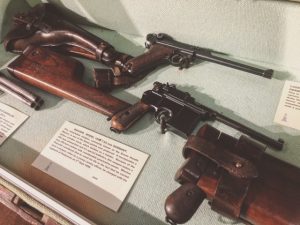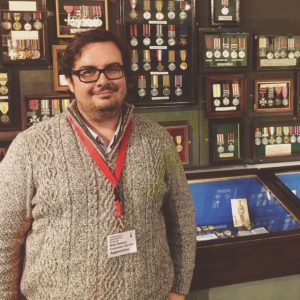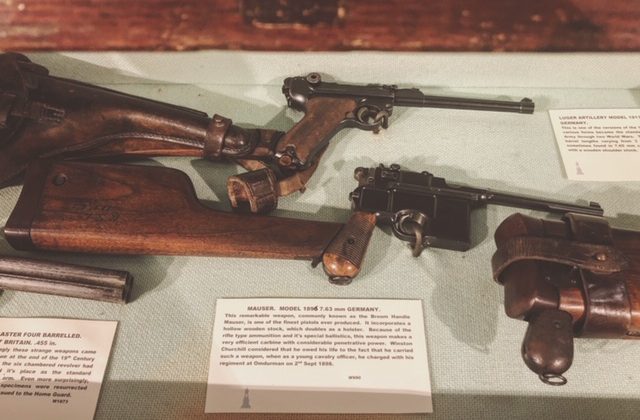By Rob Palmer, Customer Service Apprentice, 2019
In the Armoury of the museum, there is a vast array of weapons on permanent display, alongside an impressive medal display which celebrates the heroism of the individual soldiers of the regiment over the centuries, but did you know that this room is also home to some cultural icons?
Guns of the Silver Screen
In the pistol and handgun display there are two that always catch visitors’ eyes. Firstly there is the Walther PPK, the main firearm of James Bond throughout his silver screen exploits of the last 50 years.
Then there is the Mauser C96, the weapon of choice of Han Solo in the Star Wars films. In the films it appears a little differently; it now sports a small scope on top of its box like body and the barrel is shorter with a silver cone signifying the business end of the weapon. In the film it no longer fires bullets, but instead fires just as deadly, laser bolts!
In the world of Star Wars this isn’t the Mauser C96, it’s a “blaster” or if you are a huge fan of the films then it’s the BlasTech DL-44 Heavy Blaster Pistol (but you already knew that didn’t you?).
The Mauser – The Odd Shaped Gun

First produced by German manufacturer Mauser in 1896, it soon found popularity with governments, civilians and officers throughout the world. It was popular as it was a semi-automatic pistol that could hold 10 rounds, reloaded by a stripper clip, and had an estimated rate of fire of about 1000 rounds a minute. Its use in China soon saw a nickname for it, the “box cannon”, based on its box-like appearance, its rate of fire and its sheer stopping power. Meanwhile the English-speaking world gave it another, “the broomhandle” or “broomhandle Mauser” due to its round wooden handle.
In fact it’s this unique design that sets it apart, offering a multi-function feature of using it like a rifle or a pistol.
During its production from 1896 to 1937, Mauser landed large military contracts from nations such as Turkey, Italy, Persia, France, Austria and Imperial Germany which would see over a million produced. This popularity would also see several licensed versions made by various companies across the world and it has often been straight up copied by imitators. It’s been the side arm of choice for the likes of Lawrence of Arabia to British officers in the First World War. From the Luftwaffe in the Second World War to the IRA, the Mauser C96 is a weapon that has been used on all sides of conflict. Its small size, high rate of fire and stopping power is testament to why it has been involved in nearly every conflict of the last 123 years.
In my research for this article I came across a story that was mind-blowing; without the Mauser C96 history could have taken a darker turn, a turn that would mean many of you reading this would not exist.
Which is why I think that this is the gun that saved the world…
The story starts in London in 1898 with an Officer due to be deployed to Sudan with the 21st Lancers, part of General Sir Herbert Kitchener’s forces. This officer is in panic mode and in his last-minute rush to prepare for deployment, he leaves his Webley-Wilkinson .445 revolver behind. Thankfully he is able to find a reputable gunsmith in the hope of purchasing a replacement but the relatively new Mauser C96 catches his eye. When he reaches Sudan he will practice with it daily and soon falls in love with the sheer firepower of it.
On the 2nd of September 1898 Kitchener’s forces were outside Omdurman and the Officer and the 21st Lancers were positioned along a nearby ridge. Ahead of them was a ravine that was not visible from their position that was approximately twenty five feet wide and four feet deep. The Lancers came upon what were thought to be a Dervish force of about 150 warriors. Unknown to the Lancers, there were in reality nearly 2600 warriors concealed in the deep ravine. The Lancers proceeded to charge the Dervish forces on horseback in a Cavalry charge.
Thankfully the Officer in this story survived and had the foresight to write about his part in the Battle of Omdurman.
“Before we wheeled and began to gallop, the officers had been marching with drawn swords. On account of my shoulder I had always decided that if I were involved in hand-to-hand fighting I must use a pistol and not a sword. I had practised carefully with [the Mauser] during our march and journey up the river. This then was the weapon with which I determined to fight. I had first of all to return my sword into its scabbard, which is not the easiest thing to do at a gallop. I had then to draw my pistol from its wooden holster and bring it to full cock….
The scene appeared to be suddenly transformed. The blue-black men were still firing but behind them there now came into view a depression like a shallow, sunken road. This was crowded with men rising up from the ground where they had hidden. Bright flags appeared as if by magic and I saw arriving from nowhere Emirs on horseback among and around the mass of the enemy. The Dervishes appeared to be ten feet deep at the thickest, a great grey mass gleaming with steel, filling the dry watercourse.
Straight before me a man threw himself on the ground…. simultaneously I saw the gleaming of his sword as he drew back for a hamstringing cut. I had room and time enough to turn my pony out of his reach, and leaning over on the off side I fired two shots into him at about three yards. As I straightened myself in the saddle I saw before me another figure with uplifted sword. I raised my pistol and fired; so close were we that the pistol actually struck him….
Suddenly in the midst of the troop up sprung a Dervish. How he got there I do not know. He must have leaped out of some scrub or hole. All the troopers turned upon him thrusting with their lances: but he darted to and fro, causing for the moment a frantic commotion. Wounded several times, he staggered toward me, raising his spear. I shot him at less than a yard. He fell on the sand and lay there dead….I found I had fired the whole magazine of my Mauser pistol so I put in a new clip of cartridges before thinking of anything else.”
He would later go on to write to a friend that:
“It was, I suppose the most dangerous 2 minutes I shall live to see. Out of 310 officers & men we lost 1 officer and 20 men killed—4 officers and 45 men wounded, and 119 horses of which 56 were bullet wounds. All this in 120 seconds.”
Had the officer been using his Webley-Wilkinson .445 revolver then it is very likely that he would have been killed during this Calvary charge; the six round capacity would have run out very quickly and an awkward horseback reload would have been the event that killed this officer. It was the higher ammo capacity and quicker reloading of the Mauser C96 that would ensure the survival of the Officer. It all meant that he was readily able to defend himself from attacks and not lose time attempting to reload.
So how did this gun save the world?
It all comes down to the identity of the Officer in the story, namely Winston Churchill! So, had he been killed on the battlefield, it could be argued, that the events of the Second World War would have played out very differently.
In my mind this would mean the defeat of British forces and the Nazi occupation of the United Kingdom, with little or no hope of liberation. With Europe now under the reign of Hitler he would be free to focus his attention on the Soviets or America, had he been successful in this endeavour then it doesn’t bear thinking about.
In my opinion it was Churchill’s leadership, character and sheer force of will that would unite and inspire that nation to stand firm against Hitler. Personally, I have yet to be convinced that there was anyone else that could have done the job as well as Churchill, so had Churchill been killed in that battle then the 20th Century would have been very different. That is the staggering impact that one man had on the world.
I appreciate that my conclusion is open to debate, I would love to know what your thoughts are on the matter. Perhaps there was another person besides Churchill who could of lead the war effort or perhaps I’m overstating the impact of the Mauser C96? Either way I would love to hear from you.
Written by Rob Palmer, Customer Service Apprentice


